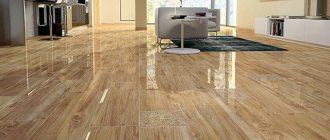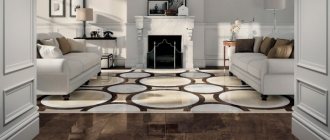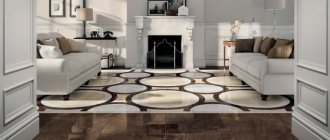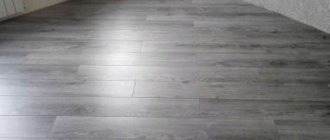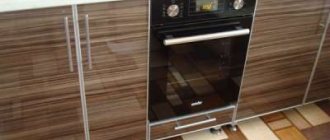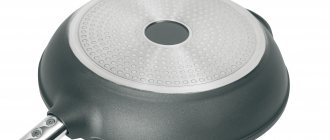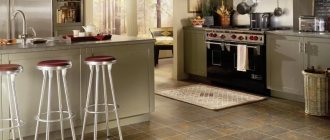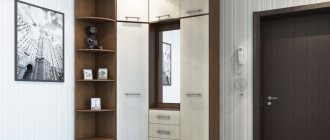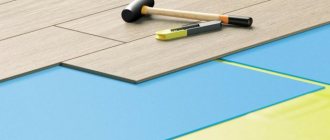Wood-look porcelain tiles (imitating parquet or boards) for laying on the floor combine the strength of stone and the beauty of natural wood. When choosing a floor covering, you should be guided by the general style decision. The use of natural materials in interior decoration is always relevant. Wood-look porcelain tiles combine the strength of stone and the texture of wood, thereby creating a warm and cozy atmosphere in the room.
Attention! Ceramic coating, despite its external resemblance to wood, is cold. Therefore, during installation, it is recommended to equip a heated floor system, which will allow you to control the degree of heating of the floor covering depending on weather conditions.
Yew, oak or ash? Simulation options
During the manufacturing process, a thin wood-like pigmented layer is applied to the porcelain stoneware blank, which gives it the appearance of parquet or boards.
Porcelain tiles are very similar in color and texture to wood fibers
Modern technologies make it possible to recreate any pattern on the tile surface that imitates the texture of wood:
- oak;
- larch;
- yew;
- ash;
- exotic trees.
At the same time, some manufacturers maintain the dimensions of products similar to those made from natural materials. For example, for greater external similarity with imitation wood, tiles can be produced not only in a standard format, but also in the form of parquet and planks.
Porcelain tiles can imitate different types of wood
In this way, it is possible to recreate both the color and shape of wooden block parquet or parquet boards.
Design
The wood-effect tile itself looks quite interesting on the wall. Therefore, in most cases it is not diluted with any decor. Designers design the cladding using the original layout, size and shape, and the use of colors of several types of wood (light + dark).
Many collections are accompanied by mosaics with the same texture and color for decoration.
Wood tiles don't have to look the same. If neighboring tiles differ by 1-2 tones or have a different texture, it will only be better!
Spanish factory Realonda, Legno collection
Gold color will look great on collections with the texture of shabby wood: it can be used in plumbing fixtures, lamps, and furniture.
Gold lamps and wooden furniture
An excellent effect can be achieved if you use waterjet cutting of tiles. It allows you to cut any shapes and curves. What can be obtained from this is shown in the photo. It is almost impossible to distinguish it from carved parquet, and this is not a drawing - each detail is cut out and laid separately, like a mosaic.
The color of the grout should not be contrasting. Choose it to match or +/- a couple of tones. If necessary, it can be tinted manually.
The wooden surface is universal - it is equally suitable for both the wall and the floor.
Area of use of wood-effect porcelain stoneware
The main advantage of porcelain stoneware is zero water absorption, due to which it is successfully used in finishing floors and walls in the bathroom, kitchen and other rooms exposed to increased influence of moisture. The highly durable material will last decades longer than any wooden flooring.
This material has also become widespread in the decoration of stairs. The design using stained wood porcelain tiles looks very original, as well as other design options for stair steps that make them stand out against the background of the general floor covering.
You can use porcelain tiles to finish floors and walls in any room, as well as outdoors
Porcelain tiles, in addition to being installed in the bathroom and kitchen, are also popular for finishing public spaces. In this case, the material is subject to increased requirements for abrasion, or an imitation of wood with a relief pattern is selected, the surface of which is polished or glazed.
Advice. Using porcelain tiles with wood imitation, you can also decorate the fireplace room in an original way. In this case, it can be used to cover the entire floor area or only fragmentarily in the fireplace area, which will eliminate the possibility of fire in this area.
What are wood-effect tiles?
It is impossible to distinguish wood-effect porcelain tiles for flooring from real parquet by their appearance. The pattern and texture of the material completely imitates natural wood, laminate, parquet and other types of wood-based floor coverings.
It is impossible to distinguish porcelain stoneware for parquet flooring from real parquet by external appearance. The difference can only be felt when walking on the surface barefoot. Unlike natural wood, baked clay is practically resistant to moisture and intense mechanical stress. Therefore, it can be safely used not only in private houses and apartments, but also in commercial premises, which include:
- restaurants and entertainment centers;
- exhibition halls and trade pavilions;
- office premises and enterprises.
Choice of colors for wood
Modern wood-look porcelain floor tiles are offered in a wide range of all possible colors and shades. Products can be polished or matte in color, of almost any texture, and can imitate piece, decorative and artistic parquet, solid wood, laminate, etc.
Using porcelain tiles you can create the illusion of parquet or laminate flooring
In modern bright interiors, porcelain stoneware flooring looks great under parquet boards in wenge or milky oak color. If this is required by the overall style decision, you can easily choose the opposite option by choosing porcelain tiles that imitate a worn “antique” surface.
The maximum resemblance to natural wood is conveyed by porcelain tiles with a textured coating. Texture can be created by structuring, when the material under pressure takes the form of a cast taken from real boards or parquet flooring. A more pronounced shade is imparted using glazing, porcelain stoneware or clay cladding - such a floor covering will be practically indistinguishable in appearance from the original.
Choice
Gray Chinese porcelain tiles
If a couple of years ago everyone tried to buy only porcelain tiles from European manufacturers: from Poland to Spain, now Chinese porcelain tiles have become a serious competitor. It is cheaper in price and often surpasses European collections in geometry.
It is better not to buy Russian-made tiles and porcelain stoneware, especially if you will be laying the cladding with minimal seams.
Color
Classic beige and light brown cladding colors will add coziness to the room.
White and dark wood colors are suitable for modern interiors. These are unobtrusive colors, so there will be no problems with combination with other interior details.
The best collections and manufacturers
The leading positions in the production of porcelain tile flooring imitating wood are occupied by Spain and Italy. Collections of famous brands Del Conca, Marazzi, Grespania, Fondovalle or Oset are distinguished by truly high quality, which the manufacturing companies monitor most carefully.
Porcelain tiles TM Del Conca
The Italian brand Inside Ceramica Fioranese deserves special attention - porcelain tiles from this series imitate prefabricated modules made of wooden blocks. The color and texture of natural parquet is provided by Montreal Venis from a manufacturing company from Spain.
When choosing porcelain tiles to match aged vintage wood, you should take a closer look at the Vintage Astor collection or Royal Sant'Agostino from Italy. In the latter case, the wood has not only stood the test of time, but also imitates hand-assembled antique floors and brushing - to achieve these effects, the manufacturer used digital printing on ceramics.
Porcelain tiles from the Vintage Astor collection
The Spanish Nuss Roca collection, stylized as parquet, or the Italian Playwood Fondovalle, demonstrating complete similarity with exotic hardwoods, will look incredibly stylish in the interior, but will not be cheap. You can save money by choosing products from a domestic manufacturer, which also offers porcelain tiles of different sizes, colors and types of processing (polished, matte, etc.).
Advantages and disadvantages
Wood is a traditional, natural and beautiful material used to decorate walls and floors. The use of wood-look porcelain tiles allows you to create an original interior that combines the decorative effect of a wood surface and ease of maintenance. The texture, pattern and embossing can almost completely imitate a parquet board.
Advantages of porcelain stoneware
Wood-effect tiles are often used to create the design of a modern room. Due to its reasonable cost, it enjoys well-deserved popularity. The advantages of using this material include:
- Resistant to high and low temperatures;
- Wear resistance and durability;
- Fire safety;
- Moisture resistance;
- Aesthetics;
- Strength;
- Environmental friendliness;
- Easy to care for;
- Resistance to chemicals;
- Easy to replace in case of mechanical damage.
The quality of modern material is so high that with the naked eye it is almost impossible to distinguish it from wood or parquet. Tiles, unlike wood, do not accumulate or transfer heat, but have higher performance properties. Porcelain tiles do not absorb odors and can withstand high loads. Floors covered with these products are not susceptible to rotting and mold.
Disadvantages of the material
But not everything is as rosy as it might seem. It is generally accepted that this is the best finishing method, taking into account the price/quality ratio. But the fact is that porcelain stoneware is tactilely cold and is not suitable for all rooms. Walking on a cold floor is uncomfortable and even dangerous. This problem is relevant primarily for families with small children.
The use of tiles in residential premises is only advisable with a “warm floor” system, which ultimately increases the cost of repairs. Given the climatic conditions in most regions, the cost of maintaining an electrically heated floor will increase significantly. Only owners of houses with a water heated floor system will benefit.
To decorate floors in technical rooms or in the kitchen, it makes sense to use lappated tiles. It looks elegant, the surface is uneven and rough due to partial polishing and removal of the thin top layer of coating.
Difficulty of installation
A significant disadvantage of the material is its difficult installation. Laying such tiles should preferably be done by professionals. The difficulty of the work is as follows.
Porcelain tile is a non-plastic, brittle material. Despite their high strength, it is quite easy to damage the tiles during transportation or careless handling. Before laying or re-laying tiles, the base should be carefully prepared; it should be as level as possible.
Porcelain tiles are difficult to cut. In order to make a cut, you need special equipment and good skills. Experts do not like to work with porcelain stoneware because it takes a lot of time to prepare. When cutting, chips often appear; if drilling is incorrect, the tiles can crack.
A large amount of consumables is required: cutters and drills quickly fail. There are especially many problems when working with large elements; large format tiles require the use of specialized cutting machines, which builders do not always have. High-quality cutting is sometimes only possible in production conditions.
In addition, oblong tiles that imitate boards are very demanding on the uniformity of the seams.
When choosing wood-look porcelain tiles, you must remember that in addition to the cost of purchasing the material, you need to set aside a budget to pay for the services of an experienced craftsman for its installation. When ordering, you should also take into account the cost of water cutting - working with cheap tile cutters can lead to damage to the material.
Features of using wood-look porcelain tiles
Porcelain tiles are thick and hard. On the one hand, this is a positive characteristic when it comes to finishing a room with high traffic. At the same time, if it is laid in a space where every centimeter is important, the choice in favor of porcelain stoneware will not be entirely successful (due to the difficulty in cutting).
The technical characteristics of porcelain stoneware tiles are such that if ceramic or glass objects fall onto such a floor, the latter will most likely break. Also, porcelain tiles can cause injuries if dropped. Some types of porcelain tiles do not look very aesthetically pleasing. This is not the best choice of finishing material for interiors where a seamless surface is required. Because when laying even large elements you cannot do without seams.
The disadvantages of porcelain stoneware, according to designers, are the impossibility of restoration. Unlike natural materials, which age beautifully and can be restored, tiles lose their attractive properties over time. It wears off, darkens, cracks, and there is nothing you can do about it. The changes are especially visible on polished and glossy surfaces.
Wood-look porcelain tiles: photo
How did porcelain tiles come about?
Such a wear-resistant material as porcelain stoneware appeared completely by accident as a result of a production error. In the process of making facing tiles, the clay mixture began to bake at a temperature that was 300 degrees higher than normal. As a result of this sintering, the components of the mixture began to interact with each other at the molecular level, which led to the formation of a super-strong monolithic block.
Types of porcelain tiles for floors and their characteristics
The resulting porcelain tile flooring board had improved technical characteristics, since it was several times stronger than ordinary ceramic tiles. In addition, it turned out that the new material is resistant to significant temperature changes and severe frosts. Thanks to this, facing tiles can be used for finishing outdoor surfaces.
Types of tile materials
An example of porcelain tiles with wood imitation
Floor tiles for laminate flooring can have almost any decorative finish, however, all types of clay tile coverings that imitate wood are usually divided into 2 categories:
Porcelain stoneware floor panels: layout options and manufacturers
- Ceramic. It is made from a clay mixture by pouring it into a special mold, after which it is fired at a temperature of at least 900 degrees. This type is more often used for private homes;
- Ceramic granite. It is made from a semi-dry mixture of clay, granite chips, sand and other additives. The mixture is fired at temperatures above 1200 degrees, which provides the tile with increased wear resistance. Thanks to its improved physical and mechanical properties, porcelain tiles for laminate flooring can be used in commercial premises (shops, offices, shopping centers).
The price for the latter type of coating is slightly higher, which is due to the more complex tile production process. However, both types of tile materials can be produced under the name wood-effect tiles, so before purchasing a product you should check this point with a consultant.
Which tile is better?
Tiles can imitate not only parquet, but also solid boards.
Ceramic tiles for wood-like floors can have a wide variety of colors and textures. In the range of tile products you can find models that imitate not only parquet, solid wood or laminate, but also leather or metal. Also, depending on the external characteristics of the tile surface, the following types of coatings are distinguished:
- Polished. The surface of the material has a mirror shine. This effect is achieved by treating the surface with abrasive compounds. Visually, the coating is quite discreet, but has a high strength;
- Satin. Before firing, the surface is treated with special compounds, which makes the tile more glossy and shiny. But this processing method somewhat worsens the floor’s resistance to abrasion, so it needs to be lubricated with mastic from time to time;
- Matte. Relatively inexpensive artificial parquet, which is devoid of “gloss”. The material is quite durable, so it is not afraid of intensive use;
- Rectified. The edges of the products are processed in such a way that no seams are formed when joining the plates. Due to this, the floor appears monolithic;
- Glazed. The design is applied to the product before enameling. Thanks to this technology, it is possible to create models that imitate not only wood, but also marble, metal or travertine.
